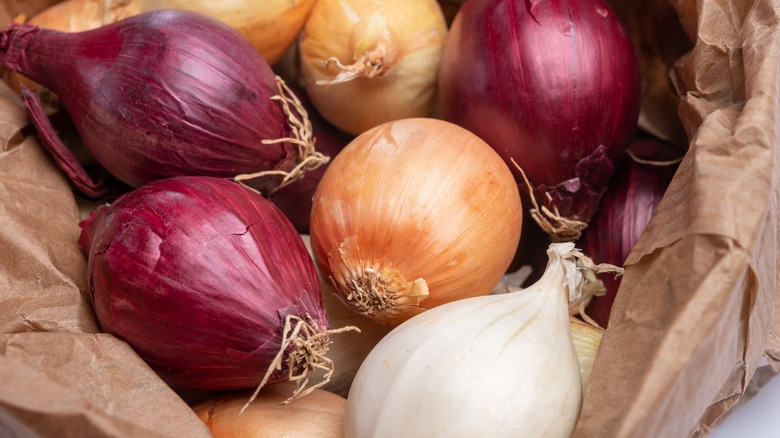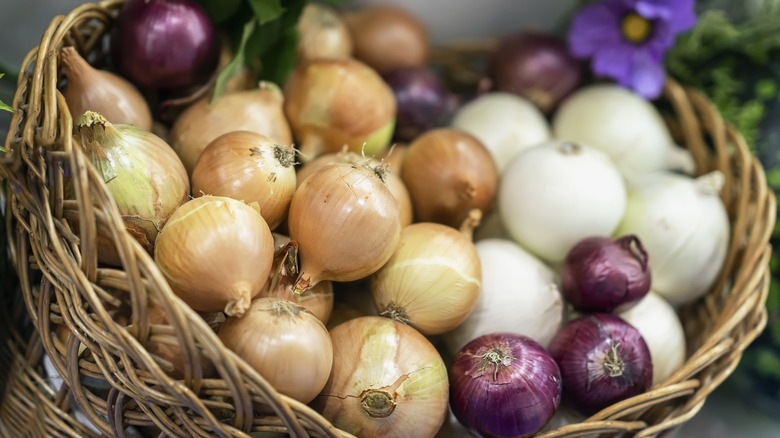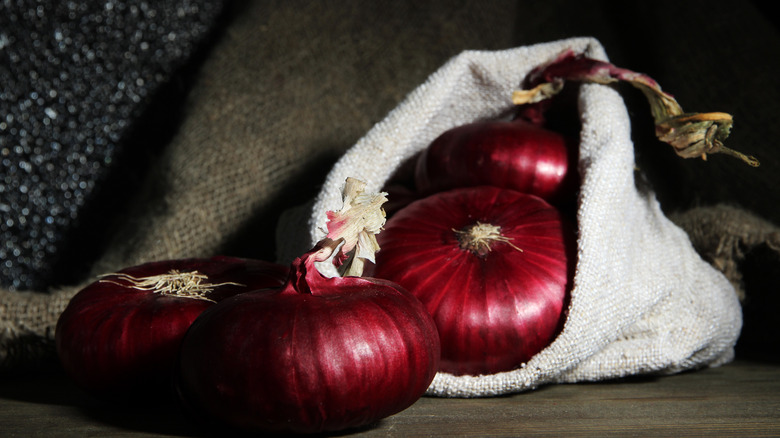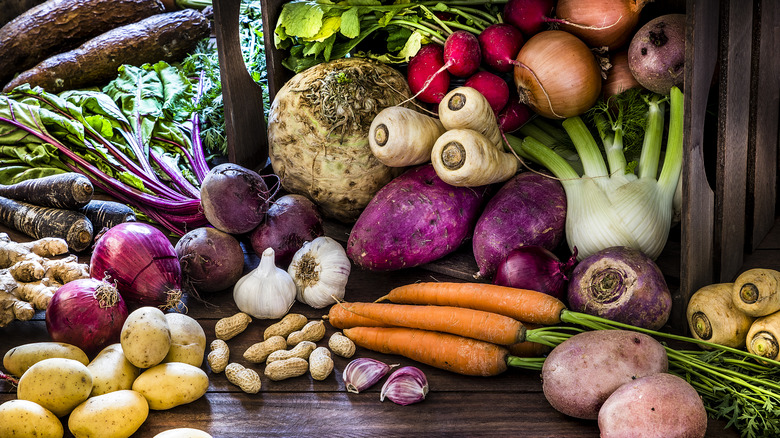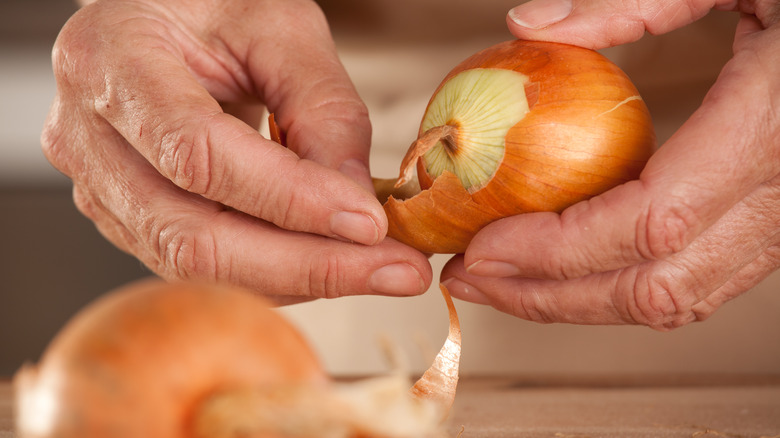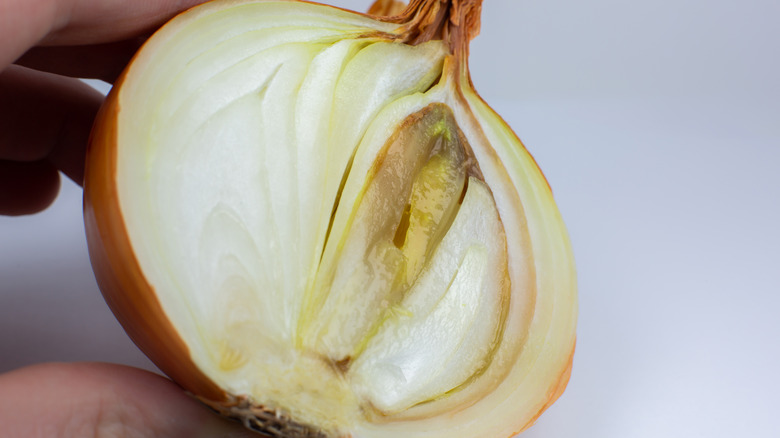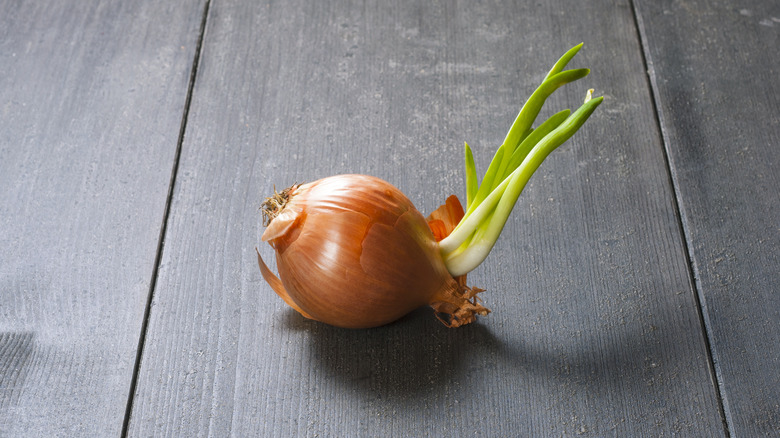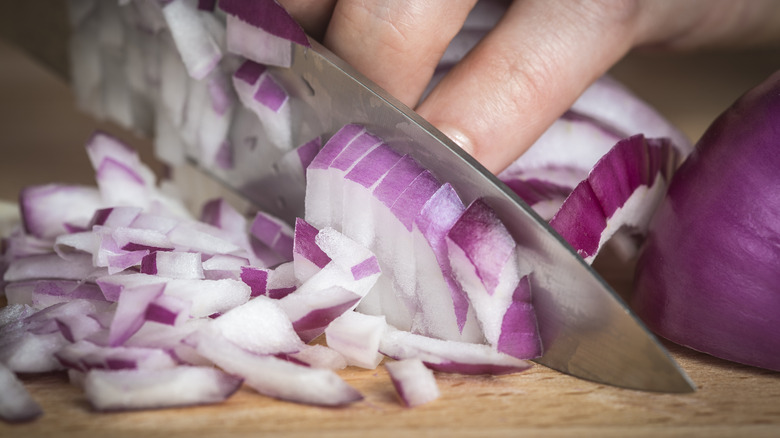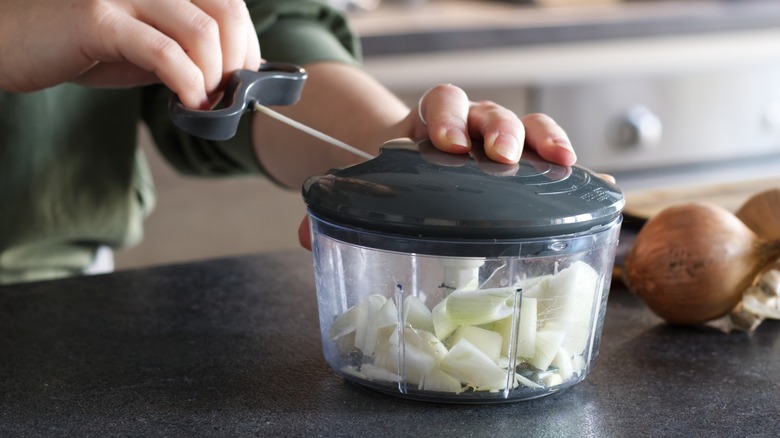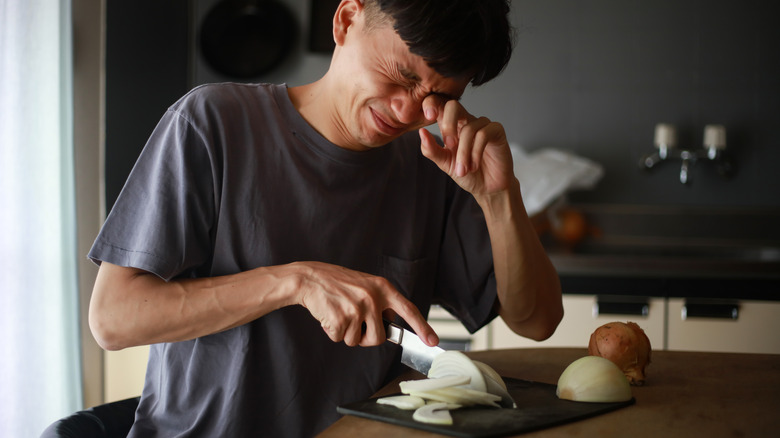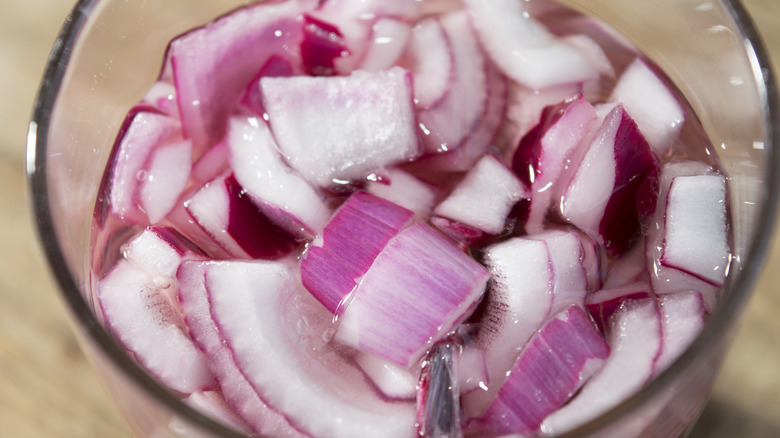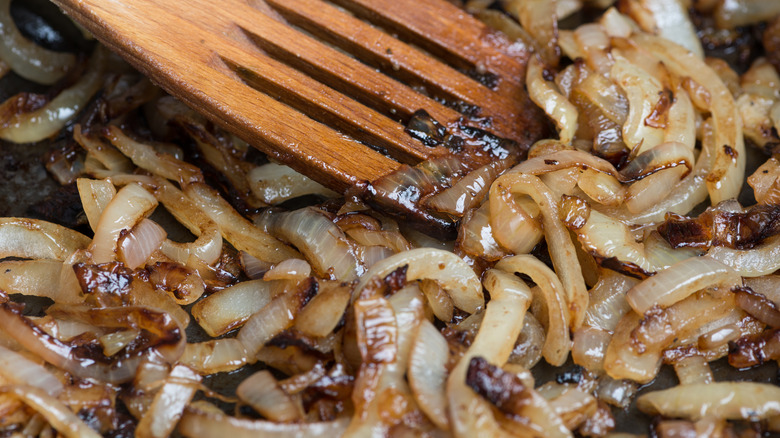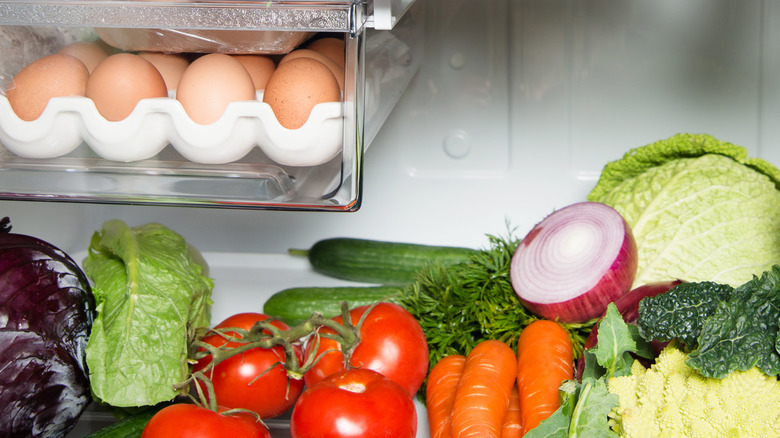12 Mistakes Everyone Makes With Onions
Onions are the unsung stars of the produce world. They're packed with incredible taste. They're affordable, hearty, and a key ingredient in all kinds of classic comfort foods, from burgers and pizza to spaghetti, chili, and more. Yet even with all the sharp, vibrant, and tangy flavor they bring to a dish, onions are also often an afterthought. Nobody gets too excited about onion-forward dishes, aside from the occasional onion ring, Blooming Onion, or bowl of French onion soup.
We buy onions because we need to have them on hand, not because we want to celebrate them and all the versatile and savory flavor they bring. And that's just one of the many mistakes people make when it comes to this aromatic, bulbous member of the Allium family (which also includes garlic, shallots, leeks, and chives).
From how we store our onions, to how we use them in the kitchen, to the methods we employ for selecting them at the market, onions are at the core of so many different mistakes we make while cooking. But it's time to rectify that, and bring onions some of the culinary recognition and respect they deserve. That starts with bringing an end to some of these common, onion-centric blunders.
Assuming all varieties of onions taste the same
You'd never look at a bunch of different melons or apples and think, "It doesn't matter which I buy; they all taste the same." But that's precisely what happens when many of us shop for onions. We might grab the yellow ones because they're in a bag and easier to handle, or the purple ones because we like the color. But have you sat back and thought about the different types of onions and what each can bring to a meal? If not, here's a quick primer:
Yellow onions are the most "onion-y" of the onion family. They have a robust, pungent flavor that balances equal parts sweetness and tang. They're also best for caramelizing, sautéing, and adding depth to soups, stews, and sauces. White onions have a more mild, herbaceous flavor. They're perfect for Mexican cuisine or eating raw in salads or homemade salsa.
Red onions (which are actually more purple in color) have a bold, sharp, peppery flavor. They're also great for cooking with or in salads, but are especially well-suited for burgers and sandwiches, where they provide a burst of tanginess. Last but certainly not least are sweet onions like the Vidalia or Walla Walla. As their name suggests, these onions are mild and earthy, with a wonderful sweetness you don't find in yellows or whites. They're also perfect for relishes, pickling, egg dishes, and stir-fries when you want a subtle yet not overwhelming hint of onion.
Storing onions incorrectly
Onions may not be as delicate as fresh berries or heads of lush green lettuce, but that doesn't mean you should be any less thoughtful when you store them away for later use. Under the right conditions, well-stored onions can last for several weeks to a few months. Stored poorly, they can turn on you — and turn bad — within a couple of weeks.
An ideal storage place for onions is cool, dark, and well-ventilated. The onions should be kept dry and in baskets or breathable mesh bags. Don't leave your onions in the plastic bags you brought them home from the market in. Plastic traps moisture and promotes mold growth and premature spoilage. Whole, unpeeled onions also shouldn't be stored in the fridge. That cold and humid environment can quickly turn them to mush.
Good ventilation in the space where you store your onions is key. If the air is too stagnant, they can start to think they have been planted underground and are more likely to grow a sprout. Direct sunlight is another definite no-no, as it can also cause onions to sprout prematurely.
Placing stored onions next to the wrong types of produce
In addition to being extra vigilant over how you store onions, you also need to be very careful what other types of produce you keep them with. Onions aren't good neighbors, and as the saying goes, "They don't play well with others." Because they both like cool, dark places, you might think onions and potatoes are fairly compatible. But that's a big mistake. In reality, onions release moisture as they age, and this dampness can cause potatoes to sprout and decay more quickly. Onions also shouldn't be stored with tomatoes. That excess water can also cause tomatoes to ripen more quickly, impacting their flavor and texture.
Onions and fruit also don't mesh well, and not just because of their contrasting flavors. Bananas produce high levels of a gas called ethylene as they ripen. When lettuce is stored next to bananas, ethylene can cause the leaves to develop an unusual form of discoloration known as rusting. Onions don't change color when exposed to the gas, but they will ripen and deteriorate faster. Onions can also impart their bitter flavor to more delicate fruits and veggies, like strawberries, blueberries, and bell peppers, meaning they should also be kept away.
So what's left? It is okay to store garlic with your onions, as well as butternut and acorn squash. Root veggies like carrots and beets also make good pantry mates, as do cabbage, cucumbers, broccoli, and mushrooms (at least temporarily).
Poor peeling techniques
One of the most unique traits of an onion over any other type of produce is its layers. You get to peel back that thin, papery outer shell to reveal the fresh, delicious veggie underneath. But even with something as simple as peeling, mistakes can be made. For instance, did you know that the root end of the onion contains the highest levels of the irritants that make us cry? Slice it off before you start peeling, and the process isn't just easier; it's also less painful.
In addition to the bottom root portion of the onion, you should also make a thin cut along the top of the onion to remove its crown before you start peeling. From there, peel with the grain of the onion — beginning at the top and peeling down — as you gradually work your way around the bulb. Tear off just the outermost layer to remove dry or damaged skin. Unless the onion is impaired in some way, don't peel into the moist, fresher layers. You'll end up throwing away more onion than you need to ... another common blunder.
To really speed up your peeling, you can pour a bit of hot water over the onion or soak it briefly in hot water. This will loosen the outer layers, making peeling more manageable. You can also nuke the onion in the microwave for about 15 seconds, which will have the same softening effect on the produce. Once warm, peel the onion as normal.
Using old or moldy onions
Life really is like an onion; you never know what you're going to find as you peel back its layers. But how do you know if something you find within those layers means your onion has actually gone bad?
In general, if the interior of an onion is soft or mushy to the touch or has a foul or off-putting smell, those are typically signs it should immediately be tossed in the trash. If you notice a light dusting of what looks like mold, mildew, or any other form of noticeable discoloration, peel back an additional layer of the vegetable. Sometimes, those defects are only on the exterior of the onion, and the inside layers are still okay to use.
However, signs of visible rot, large dark spots, slimy texture, unusual wetness, or extremely shriveled or wrinkled skin are indicators that your onion is too far gone and should be tossed in the trash. If you're ever in doubt over an onion's freshness, take a small bite of the veggie raw. If the onion tastes weird or has an off-flavor, it's also time for it to be discarded.
Throwing away onions that have sprouted
Much like a wild flower growing up through the cracks in a sidewalk, life always finds a way. And sometimes, that means vibrant green tendrils emerging from an onion where none existed just a day or two before. But while it can be fairly obvious when you need to throw a stinky, mushy onion into the trash, onions that have sprouted often look perfectly fine — aside from that green alien appendage sticking out of them. So what to do?
It turns out that onions that have sprouted are perfectly fine to eat. So don't toss it. Instead, slice off the sprouted portion of the onion, peel the bulb, and then split it in half. The sprout may also have started to "absorb" some of the onion's inner layers. If you see that has happened, throw those sections away, and then feel free to use the exterior. Just note that onions that have sprouted tend to be less crunchy, and will also be noticeably more bitter. This happens because the growing onion sprout absorbs sugar from the bulb as it develops, changing the onion's taste.
If you're feeling especially good-hearted and want to embrace the full cycle of life, you could also take that sprouted onion and drop it into your garden or even a medium-sized flower pot filled with potting soil. With plenty of sun and regular water, you'll have a whole new, homegrown onion ready for harvest in just a few months.
Cutting onions with a dull knife
Sharp knives aren't just crucial for cutting into proteins. They also make a world of difference with all kinds of produce. Slicing onions, in particular, with a dull knife is a mistake too many of us make all the time.
Dull knives struggle to make clean, even cuts, even in relatively firm and solid foods like onions. When you use a dull blade, you crush the layers in your onion rather than cleanly slicing through them. This releases more irritants into the air and makes cutting onions a more painful experience — you're more likely to cry when you cut onions like this. It also bruises the onion and can change its flavor. Onion cut with a dull knife tends to be more bitter and potent, and is also more likely to turn stringy or mealy as it cooks.
Perhaps worst of all, using a dull knife to cut onions is also a safety hazard. Knives are more likely to slip on an onion's surface when they are dull, putting your fingers in harm's way. And since cutting with a dull knife requires more force and effort, if you do cut yourself, it's likely to be deeper and more severe than it would have been if you were using a sharper blade.
Not using an onion chopper
Space is a hot commodity in any kitchen. You don't need drawers filled with useless silicon ice cube molds or quirky novelty things you only use once a year. But when it comes to specialty gadgets and appliances, an onion cutter can be worth its weight in gold — especially if you eat a lot of onions. Not investing in one is a definite mistake.
For starters, onion choppers are incredibly quick to use. They reduce the amount of time required to chop or dice onions, dramatically streamlining food preparation. These gadgets also ensure uniform and consistent cuts. This is important for presentation and consistent flavor, of course, but it also helps with preparing everything from salsas to relishes to the classic combination of chopped onions, carrots, and celery known as mirepoix. The more evenly those veggies are cooked, the more likely they are to cook at the same rate, reducing the risk of over or undercooking.
Onion choppers are also great fatigue busters if you need to cut a large amount of onions for a recipe. They're user-friendly, so they're an excellent way to let kids help in the kitchen without having to handle sharp knives. And they clean up quickly and often make less mess overall than a cutting board and knife station. They're a win-win all around!
Letting onions make you cry
There's a reason cutting onions makes us cry. Those tears are a byproduct of the sulfur-packed gas that escapes from the cells of onions when you slice into them. These irritants flood the eyes in a wave, and you tear up instantly as a result. It's a reflex we can't control, and that can happen to anyone, whether our eyes are exposed to dust, pollen, or a potent whiff of freshly cut Walla Walla.
Fortunately, there are ways to reduce levels of these gases and make cutting onions a less teary experience. Removing the root end of the onion before you begin slicing helps. You can also chill your peeled onion in the freezer for a few minutes before you cut into it. It turns out the colder an onion is when you slice into it, the harder time that tear-inducing gas has escaping its flesh. You can also slice the onion under running water to preemptively wash away those painful gases.
Some home cooks also swear by slicing onions near an open flame, such as turning on your stove's gas burner before you cut into the onion. The theory here is that the flame will help burn off some of those irritants in the air before they can reach your eyes. If nothing else, you can also protect your eyes with a good pair of onion goggles, which create a barrier to prevent irritants from reaching your eyes.
Not soaking onions before eating them raw
Ever notice how the slice of onion on your homemade burger has way more bite than the onion on the burger at your favorite restaurant or bar? It's not just quirky luck. Most professional chefs know to soak an onion before serving it raw. The rest of us rarely consider such a thing — another huge mistake when it comes to dealing with onions in the kitchen.
Soaking raw onion in cool water for 15 to 30 minutes before you use it helps to mellow the flavor of the onion. It takes out some of that sharpness and intensity and makes the onion more enjoyable to eat. Soaking onions also enhances the crispness of the vegetable, dials back that potent onion odor, and makes them more palatable overall. And perhaps most importantly, if you're the type to reach for antacids after certain meals, soaking onions also makes them easier to digest, reducing the risk of heartburn and bloating later in the evening.
Plus, after you've soaked an onion, there are ways you can put the leftover onion-infused water to use. It's great for bringing added flavor to rice or pasta, or to use when steaming vegetables. The water leftover from soaking onions can also be used in marinades for meats or vegetables or as a base for homemade soups and stews. You can even use it when braising, adding gentle hints of onion to anything you might be cooking.
Caramelizing your onions too quickly
Caramelizing onions is a lot like making a great homemade pasta sauce. It's a labor of love — and it takes time. You can't rush it, especially if you want onions with that incredible sweet, smokey, charred flavor that makes everything they touch taste better.
To make perfectly caramelized onions, start the cooking process over low heat and build gradually. Don't start with your burner set too high — you'll burn onions before they can even begin caramelizing. Also, avoid overcrowding the pan. If you put too many onions in to cook all at once, the onions will release too much moisture and won't have a chance to sear and brown on the skillet's surface properly.
Finally, be sure to add both salt and a bit of sugar to your onions as they cook. The salt helps draw moisture from the onions, promoting better browning. And the sugar enhances that browning, adding color and flavor to your finished dish. Keep stirring to a minimum — the more contact the onion slices have with the pan's heat, the better they'll brown. Most importantly, be patient. Caramelization takes time, and the slower you go, the better your onions will taste in the end.
Storing leftover onions uncovered in the fridge
We get it — cleaning up after preparing a meal is no fun. Sometimes, you just want to shove your leftovers into the fridge and get back to your Netflix binge. But when it comes to leftover onion in particular, that's a huge mistake. For starters, if onions are stored uncovered in your refrigerator, that potent onion flavor can transfer to all your other foods. Dairy products like milk, butter, and cheese are especially susceptible to picking up unwanted flavor contaminants, like the flavor of raw onion.
The cold of the fridge is also no good for your leftover onion. It can increase the bitterness of the veggie and also zap away its crispness. And because the refrigerator is a humid place, uncovered onions are also more likely to spoil quicker than if stored properly. Peeled, diced leftover onion should ideally be kept in a sealed, airtight container; placed in a resealable plastic bag; or wrapped tightly in plastic wrap. Place a dry paper towel in the container with the onion to help absorb excess moisture. Then, use your leftover onion within three to four days for maximum freshness and flavor.

